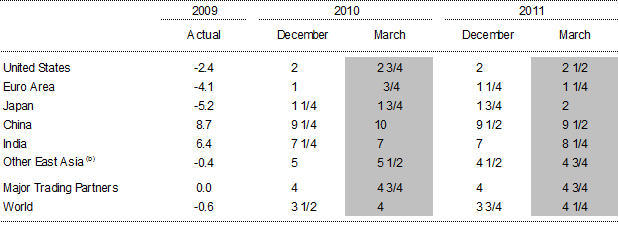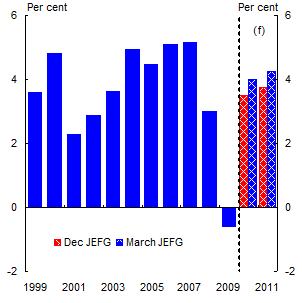Table 1: International GDP growth forecasts(a)

(a) Calculations for World and euro area growth rates use GDP weights based on purchasing power parity (PPP). Calculations for Major Trading Partners and Other East Asia use export trade weights.
(b) Other East Asia is: Korea, Taiwan, Hong Kong, Singapore, Indonesia, Malaysia, Thailand, Vietnam and the Philippines.
Source: National statistical publications, IMF and Treasury.
World outlook
The outlook for the global economy continues to improve. While concerns over sovereign debt are likely to remain a source of risk and volatility for the next several years, the recent data points to a global economy that is performing better than envisaged at the time of the December JEFG forecasting round.
Part of the improved optimism is directly attributable to the stronger‑than‑expected performance at the end of 2009 among our major trading partner (MTP) economies. GDP outcomes in the December quarter were generally strong, and in some cases, surprisingly so, particularly in East Asia. While the accelerating growth phase in the global economy looks to have passed, a more moderate growth path is the most likely scenario from here, although a double‑dip in some of the European periphery economies remains likely.
Despite stresses in some sovereign debt markets, financial market conditions more broadly continue to improve. Short‑term inter‑bank funding spreads remain at near pre‑crisis levels, long‑term bond spreads continue to normalise, activity in securitisation markets has picked up while market volatility has fallen to near its long‑run average.
Against the backdrop of stronger growth, continued healing in overall financial conditions, and emerging signs that the economic recovery has broadened beyond the global industrial cycle, global growth forecasts have been marked up by ½ of a percentage point for both 2010 and 2011 (Chart 1).
Chart 1: World GDP growth
IN
Source: IMF and Treasury.
The outlook looks especially encouraging for emerging markets, and in particular, our Asian neighbours. China is forecast to grow at a double‑digit pace this year. Reflecting the relative outperformance of our major emerging Asian trading partner economies and their larger share of our export market, MTP economies are forecast to grow more rapidly than global GDP, with growth of 4¾ per cent in both years.
The divergence in growth performance will see a disparity in the pace of monetary policy normalisation. Among our major developing trading partner economies, monetary policy normalisation has either already commenced or is imminent, while in our major developed trading partner economies, this process is not expected to occur until towards the end of 2010 at the earliest.
While the outlook has improved noticeably compared to where we stood just three months ago, there are still important risks in both directions.
The most obvious downside risk relates to the sustainability of sovereign debt as the situation in Greece acutely demonstrates. At a time where large parts of the global economy are transitioning from policy‑induced growth to self‑sustaining expansion, there is a real risk that this transition is disrupted by the need to bring forward fiscal consolidation measures. Although this is a low probability risk, should such a scenario unfold, it would have serious negative consequences. In addition, there may be subsequent negative ramifications for business and consumer confidence, which would lead to private sector retrenchment, and cause further strains on already fragile economies.
Fiscal consolidation plans will eventually need to be enacted across many economies, which will lead to a more subdued outlook for advanced economies in the period ahead. In contrast, emerging economies are coming out of this crisis with lesser concerns over sovereign debt.
On the upside, however, there is the possibility that we may be underestimating both the short term momentum of the global economy and the positive feedback of improving confidence on economic conditions.
Country summaries
The outlook for the United States continued to improve in late 2009. A turn in the inventory cycle and expanded business investment and consumption supported strong growth in the December quarter. Despite ongoing strains from a weak labour market, constricted credit flows and past asset price shocks, US households have been more resilient than expected, boosting the outlook for consumption growth.
Accordingly, forecasts for 2010 and 2011 have increased to 2¾ per cent and 2½ per cent, respectively. Nevertheless, the recovery in the US economy is still expected to be sluggish and protracted compared with past recessions. While the outlook for consumption has improved, spending is expected to be subdued as cautious households grapple with damaged balance sheets and a tepid labour market recovery. With final domestic demand still subdued and considerable policy support set to expire over the forecast horizon, there is considerable uncertainty about the sustainability of the recovery. A faster‑than‑expected rebound in employment and a resumption in house price growth could prompt a stronger recovery in household spending. However, fading support from policy measures — particularly those targeting the housing market and disposable income —suggests some downside risk to the outlook.
The outlook for China has been upgraded since December JEFG, with government stimulus providing a stronger‑than‑expected boost to growth. GDP grew by 8.7 per cent in 2009, higher than forecast, driven by an acceleration in domestic demand. Expansionary monetary and fiscal policies have driven China's recovery, with investment contributing a strong 8 percentage points to growth in 2009.
With support from stimulus expected to continue into 2010, China's economy is forecast to grow by 10 per cent in 2010, before easing to 9½ per cent in 2011. Consumption has remained solid and export growth has rebounded. However, strong domestic demand has heightened concerns over asset price bubbles, inflationary pressures and overheating.
The Government has implemented measures to reduce liquidity, raising reserve requirement ratios for large banks by 100 basis points and cautioning banks against excessive lending. Fiscal stimulus is expected to be redirected from investment towards consumption. However, monetary and fiscal policies remain clearly expansionary. Risks centre on the Government's ability to manage domestic overheating, while countering the effects of a potentially subdued global recovery.
The recovery in the Japanese economy is delicately poised. The strong recovery in exports and production evident during the past year is likely to continue to drive growth. Much of this growth is expected to come from emerging markets, as highlighted by China's replacement of the US as Japan's largest export destination last year. In addition, fiscal stimulus will continue to provide support to consumption. In March this year, Japan's lower house passed a record ¥92.3 trillion ($A1.15 trillion) budget for FY2010 which includes a range of measures to support consumption, including direct payments to households.
However, substantial downside risks to Japan's growth remain. The rapid rate of increase in Japanese exports is expected to slow as the global export rebound settl
es. Domestically, the signs are improving, but the pace of recovery in some areas has been painfully slow. While unemployment has peaked, falling below 5 per cent in January, low wages are holding back the recovery in private consumption. Business investment appears to have bottomed out, but the sizeable output gap and prolonged deflation suggest it is likely to remain subdued during 2010.
The economy is expected to grow by 1¾ per cent in 2010 and 2 per cent in 2011. These above‑trend rates of growth largely reflect a rebound from last year's record annual fall in GDP rather than inherent strength in the Japanese economy. Enduring recovery will hinge on the extent to which deflation becomes entrenched and whether the recovery in the corporate sector spreads to households, thereby allowing domestic consumption to develop its own momentum.
The outlook for the Indian economy remains strong, notwithstanding a weaker‑than‑expected December quarter result, a consequence of India's worst drought since 1972. Despite this setback, the recovery in the Indian economy is expected to be sustained on the back of improved business and urban consumer confidence, improved weather conditions, a better outlook for key export economies, and renewed foreign capital inflows. The Indian economy is forecast to grow by 7 per cent in 2010 before accelerating to 8¼ per cent in 2011.
As a result of the drought, food prices have risen markedly, propelling inflation into double‑digits, although inflation is expected to ease once the winter crop is brought into the market around March and April. Monetary policy remains highly accommodative, which should continue to support activity, while the authorities' commitment to fiscal deficit targets is expected to improve investor sentiment.
The recovery of the Newly Industrialised Economies (NIEs) has proved to be more solid than expected amid continued improvements in the global economy. The NIEs are expected to grow by 5½ per cent this year and 4¾ per cent in 2011. The outlook for exports and industrial production is generally positive, with restocking of inventories in the advanced economies providing a significant boost. However, inflation is rising, as already seen in some property markets.
Economic activity in the ASEAN‑5 has continued to gather momentum, supported by improved exports and expansionary monetary and fiscal policy, which saw the region stage a V shaped recovery over 2009. The year ahead is again expected to be characterised by the strong export led recovery that is currently underway, with economic growth in the region's relatively small, open economies likely to benefit from strong intra‑regional trade — particularly to China — and the normalisation in world trade.
The region is forecast to grow by 5¾ per cent in 2010 and 5¼ per cent in 2011. The outlook for the year ahead is however tempered somewhat by the risk of overheating in Vietnam, while political frailties in the region, particularly in Thailand, also pose downside risks.
The recovery in the euro area has slowed recently as weak domestic demand continues to detract from growth. While net exports are expected to provide some support as world trade strengthens, rising unemployment and ongoing deleveraging by households should continue to dampen private consumption. Uncertainty over sovereign debt levels in some countries is also weighing on sentiment across the euro area. As a result, the recovery is expected to remain drawn out and sluggish, with GDP forecast to grow by ¾ per cent in 2010 before strengthening slightly to 1¼ per cent in 2011.
The United Kingdom economy ended six consecutive quarters of negative growth in the December quarter 2009. However, the recovery is expected to be feeble and prolonged, as growth is held back by tight credit conditions. High levels of public and private debt, the need to unwind the large policy stimulus and the uncertainty surrounding this year's election will also weigh on the recovery. After contracting by 5 per cent in 2009, GDP is forecast to record modest growth of 1 per cent in 2010 and 2 per cent in 2011.
Forecasts for New Zealand GDP growth have been upgraded, with growth expected to pick up from 2¾ per cent in 2010 to 3¼ per cent in 2011. The New Zealand recovery reflects improved global growth, housing strength and government spending. Despite expected interest rate increases, household consumption is forecast to rise and business investment is expected to strengthen. Export commodity prices have risen recently, boosting the terms of trade, although export gains are likely to be partially offset by the recent appreciation of the New Zealand dollar.